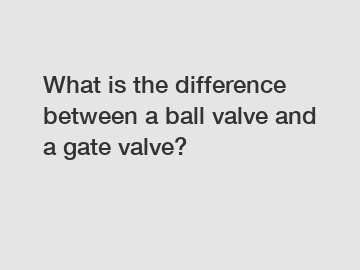Feb. 23, 2024
Mechanical Parts
Ball valves and gate valves are two common types of valves used in plumbing, industrial processes, and many other applications. While both are designed to regulate flow within a system, they operate in slightly different ways and have distinct advantages and disadvantages. Understanding the key differences between ball valves and gate valves can help you determine which is best suited for your specific needs.
**Construction and Operation**.
Ball valves get their name from the spherical ball inside the valve body that controls the flow of liquid or gas. When the handle of a ball valve is turned, the ball inside rotates to either allow or block the flow of fluid through the pipe. This type of valve is considered a quarter-turn valve because it only requires a 90-degree turn of the handle to open or close the flow completely.

On the other hand, gate valves use a gate or wedge-shaped disc to control flow. When the gate valve is fully open, the disc is lifted out of the flow path, allowing unrestricted flow. To close the valve, the disc is lowered back into place to block the flow. Gate valves require multiple turns of the handle to open or close fully, making them slower to operate compared to ball valves.
**Flow Control and Pressure Drop**.
Ball valves offer excellent control over the flow of liquids and gases due to their full-bore design, which minimizes pressure drop across the valve. This design also allows ball valves to provide quick shutoff, making them suitable for applications where tight shut-off is essential. However, ball valves may experience issues with cavitation in high-pressure applications, which can cause vibration and damage to the valve.
Gate valves are known for their ability to provide a tight seal when fully closed, making them ideal for applications where leak prevention is critical. However, their design can lead to higher pressure drop when compared to ball valves, which can impact the efficiency of the system. Additionally, gate valves are more prone to wear and corrosion over time due to the sliding motion of the disc against the valve body.
**Applications and Suitability**.
Ball valves are commonly used in applications where fast operation and reliable shutoff are essential, such as in water supply systems, oil and gas pipelines, and chemical processing plants. Their ability to handle high-pressure and high-temperature conditions makes them versatile across a wide range of industries.
Gate valves are frequently used in applications where a tight seal is required, such as in steam systems, wastewater treatment plants, and fire protection systems. Their ability to withstand high temperatures and abrasive media makes them suitable for specific applications where other types of valves may not be as effective.
In conclusion, the choice between a ball valve and a gate valve depends on the specific requirements of your system. While ball valves offer quick operation and minimal pressure drop, gate valves provide a tight seal and resistance to wear and corrosion. Understanding the differences between these two types of valves can help you make an informed decision for your application.
If you have any questions or need further assistance in selecting the right valve for your needs, please do not hesitate to contact us.
Want more information on Marine Cast Bronze Valves company, High Temperature Impulse Safety Valve, China forged steel 20k angle valves factory? Feel free to contact us.
If you are interested in sending in a Guest Blogger Submission,welcome to write for us!
All Comments ( 0 )